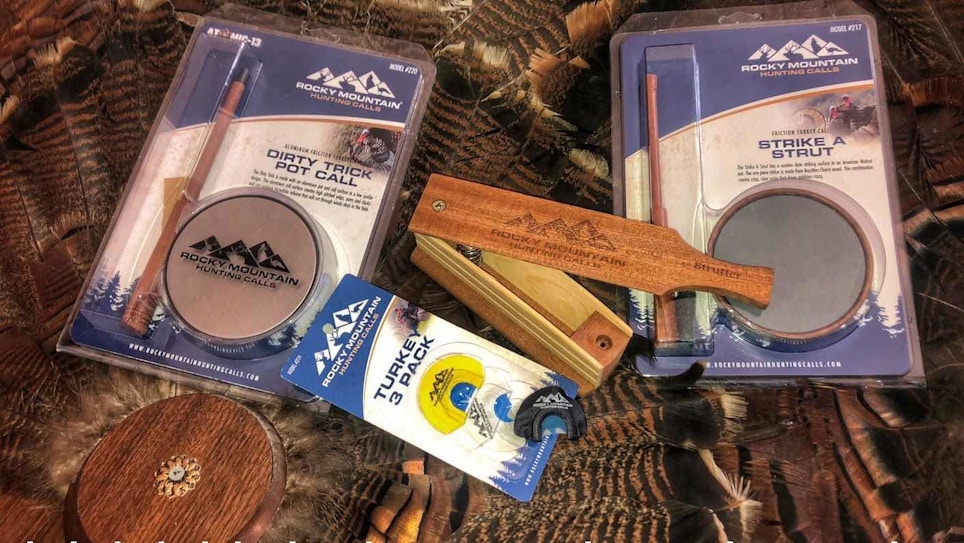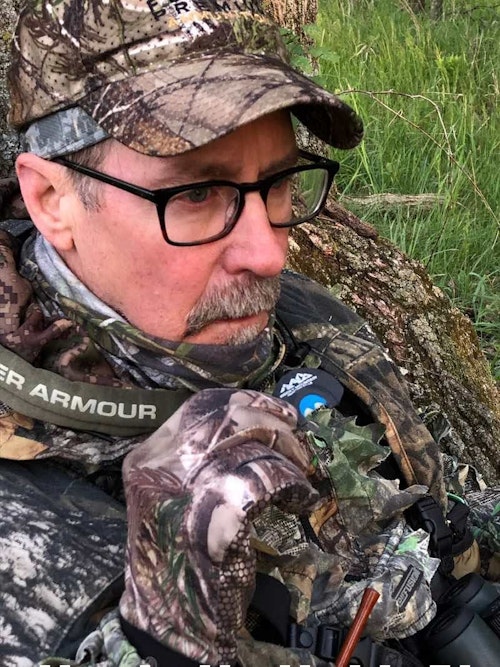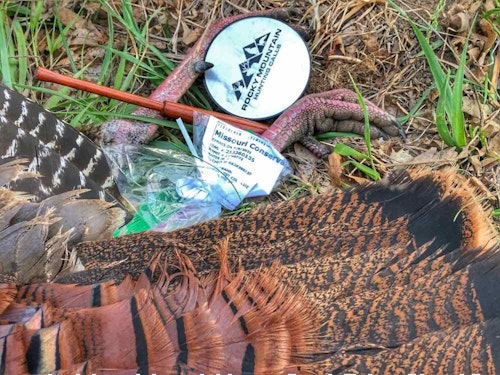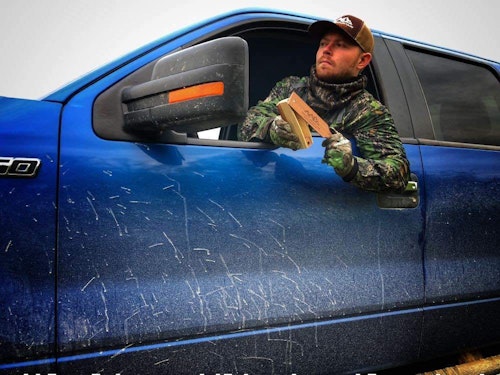
Owning a wide variety of turkey calls increases the probability that you’ll have the one needed to trip the trigger of a hesitant tom.
In the infamous words of baseball legend Yogi Berra, “It was déjà vu all over again.” Two toms were pacing up and down the opposite side of a dilapidated fence as my hunting buddy Nick Mattly and I did our best to melt into the twin trunks of an ancient oak — the very tree, in fact, from which we’d nailed a tom three days earlier. Thanks to Missouri’s two-bird limit, we were back at it and staring down the possibility of a repeat.
To be honest, we’d gotten extremely lucky. Unlike the bluebird morning that greeted us when we’d killed the first tom, the weather was now miserably cold, wet and windy, and we’d elected to exercise our most humane option — to sit out the morning in a pop-up blind where we could stay dry and out of the wind, hoping a hapless turkey might happen by.
I’d been hammering away on my diaphragm call for more than two hours with zero response and couldn’t take it anymore. “What do you say, Nick? Let’s get out and take a walk to warm up a bit.” We’d scouted a small food plot in some heavy timber the previous day and figured it was our best option for getting out of the wind where just maybe we could get a tom to fire up. “Sure thing,” Nick was all for it.
Iowa native Nick Mattly, son of my good friend Mike Mattly, sales and marketing director for Rocky Mountain Hunting Calls, was my companion for the three-day hunt — his youthful exuberance and homegrown hunting skills welcome support. Rocky Mountain produces a variety of turkey calls including the box call, pots and diaphragms I was using for this hunt.
Mike was hunting with another good buddy, Josh Dahlke, who I’d ridden with from our home state of Minnesota. Josh is Media Content Director for HuntStand, a premier mobile navigation/hunting app, and had drawn and Iowa tag, but I hadn’t. Cody Hinson, a family friend of the Mattly’s, had come up with a solution by securing the farm where Nick and I were hunting just over the border in the Show Me State. Thanks, Cody!
I exited the blind and to my surprise was immediately staring down five jakes that were staring right back! They were just over a rise in the field about 60 yards from the blind where we hadn’t been able to see them for who knows how long, and they hadn’t made a sound — at least none that we could hear. They bolted in a flurry of wings as Nick followed me out of the blind. “Dammit,” he said with total disgust — his outburst met by a weak gobble from down a dim field road that meandered west to an overgrown pasture. Wait! What?!
We scrambled to the sparce cover offered by the huge oak and tried to figure out exactly where the gobble had come from. I hit the mouth call and got a wind-muffled response — and then another. There were two toms pacing back and forth along on the opposite side the gated fence a hundred or so yards down the two-track. Moving into a better position wasn’t an option, so I continued blowing the diaphragm call, trying to generate enough volume to cut the wind. “They’re on our side of the fence!” Nick looked up over his bino. “They’re moving down into the woods heading northeast.”
I scooted around to get a better angle, took my best guess at where they might show up and rested the 12-gauge on my right knee — which lined me up almost exactly in the lane where I’d dropped the tom at 40 yards three days earlier. One of the birds gobbled. They had closed about half of the distance to us and were still on track to show up to my left. And then they were quiet. About five minutes passed, and just as I was getting concerned, I caught movement to my right! Evidently, the toms had passed by us just out of sight and were now doubling back looking for the source of the hen yelps. They were only 25 yards away, but I didn’t dare move, so I waited for them to walk into the sights of my 870.
When the toms finally gave me a shot opportunity, they were so close together that I stood a good chance of adding collateral damage, so I eased back on my trigger finger. The drama finally ended when the birds separated, and I sent swarm of angry Federal No. 7 TSS pellets at the tailing bird. I fist-pumped Nick and let out a huge sigh of relief. Not in my wildest dreams did I think we’d have much of a chance of tying a tag to a tom once we left the blind. With the wind and the cold and the rain, there was just too much working against us. But you’ve got to try, right? And the decisions made on the fly often dictate success or failure.

The choice of which calls to use and when is one of those factors. I’d stuck with a diaphragm call that morning for good reason. They operate better than friction calls in wet conditions, produce a wide variety of turkey vocalizations and own the volume needed to buck moderate wind. The morning I’d killed my first tom I’d gone a different route. It was a calm morning, and the subtle yelps, clucks and purrs pot calls deliver got the best response. The fact is, different situations call for different calls and different approaches to the game. And oftentimes it’s the turkey that makes the decision regarding which calls trip his trigger. That’s why it might be necessary to sift through several calls before you find one that generates a response.

The Spice of Life
Have a look in any fisherman’s tackle box, and there’s sure to be a wide variety of lures of all shapes, sizes and colors. Experience has taught anglers that they must be prepared to tackle various light and water conditions, as well as multiple fish species and sizes. And they need to be equipped to mimic the most prevalent natural food sources — and to roll with the whims of those pea-size fish brains. They often sift through a large assortment of different size and color lures before landing on that perfect combination that provokes a feeding frenzy on that particular occasion. An hour later, all bets might be off, and a completely different setup might work better.
Same goes for calling tom turkeys — those fickle birdbrains we love to hunt. Different situations require different approaches and applications. Some choices can be made before striking out — a reflection of current weather conditions, hunting pressure, time of year, whether toms are henned up, etc. Refinements can be made on the fly as conditions dictate. Turkey hunters might run through several diaphragm, box and slate calls during the course of the morning before finding the one that gets a hung-up tom to fire up and come their way.
Mike Mattly says it’s just a matter of running through a variety of calls to — just like the fisherman — find one that works for that particular time and situation. “One hunt I can recall,” he told me over beers one night, “we saw two longbeards strutting and put a sneak on them — got to about 100 yards. I had four different diaphragm calls in my pocket that day and I put one in and made a series of calls. They never even acknowledged it. I spit it out and did the same with another. Nothing. The third one, same thing. Finally, I hit the fourth call and they both gobbled and turned around and came right in. We shot both of those birds. So, it was just that different tone, or different pitch, that finally tripped their trigger.”
Dahlke told a similar story. “There’s one encounter that sticks out the most in my head,” he said. “I’d thrown several diaphragm calls, a box call and a pot call at a tom and he was completely unresponsive. He was up on this ridge and didn’t even look down at us. Finally, I hit a different pot call and his head snapped up and he looked down at us and just turned inside out.”
And that punctuates the importance of carrying — and applying — a variety of calls. Let’s take a look at various turkey calls and their application potential — starting with locator calls.
Getting a tom to respond from the roost — whether it’s putting him to bed in the evening or getting him up in the morning — provides the intel needed to put yourself in the best position to call him up when he pitches out of the tree at pre-dawn, and that means using locator calls. These calls include crow, coyote, owl, woodpecker and others. And variety is important here, too. Oftentimes, it’s necessary to go through several calls before finding one that gets a response. I typically carry three — a crow call, coyote howler and rabbit-in-distress call.
Dahlke believes that in addition to volume it’s the tone or pitch of the call that triggers the shock gobble — maybe even causing a physical or chemical reaction in their brain. “Sometimes they shock gobble at only a crow, sometimes only a coyote or an owl,” he said, “and it’s like when that sound hits them a light switch goes on.”
Locator calls can also be used when run-and-gun hunting. I recall one stubborn Black Hills tom that shunned all of my turkey talk but would respond to the crow call nearly every time I hit it. So, by using that locator call I was able to keep tabs on the bird and then finally get into position where I could set up a decoy and get on the slate and diaphragm call. An hour later, the tom came in silent, and my son was able to make the shot.
Aside from locators, turkey calls generally fall into two categories: mouth blown and friction. Mouth calls include diaphragms and wingbones and friction calls include pots, box calls, push buttons and the like. And in both of these categories, calls can produce a variety of unique sounds based on their size and design and the materials from which they’re made. Determining which calls are best suited for a particular situation is often based on several criteria. Here’s the good, the bad and the ugly on each with a few nuggets from Mattly and Dalhke’s playbooks.

Diaphragm Calls
Good news — Diaphragm calls are a good choice because they are versatile and can produce a variety of turkey vocalizations, such as yelps, cuts, purrs and even gobbles — as well as coyote howls for locating birds. Dahlke says the mouth call is his go-to call because he is able create so many different sounds with it — even different tones with the same call — and he likes their hands-free operation. “I’ll always start with the mouth call and go through and exhaust everything I can do with it,” he said. “If I don’t get a response, only then will I switch.” Dahlke says that once he gets a bird started, he likes to finish with that call. So, if he starts with a mouth call and gets a response, he sticks with it — and that means hands free calling right up until he tugs the trigger.
Mattly says that with diaphragm calls it’s all about the user’s comfort level — because they’re more difficult to master. “With diaphragm calls the No. 1 question we get from consumers — whether we’re talking elk or turkey calls — is which one should I use? “We ask them how long they have been using them and how comfortable are they with them? What’s their skill level?”
And that’s the key, according to Mattly. Make sure they’re using a call that corresponds with their skill level. “We started labeling our diaphragm packaging to differentiate between the calls we manufacture — Novice, Intermediate and Advanced,” he said. “So when hunters are making that purchase they’re getting a call for their skill level so they can have better success with it. And when they get more accomplished, they can graduate to that next step up.”
Bad news — One downside is that mouth calls can be tough to master and require a fair amount of practice. A good buddy once told me that you aren’t an expert with a diaphragm call until you’ve swallowed one of every color. And while they produce a fair amount of volume, sometimes they’re just not loud enough to cut through extreme wind or heavy cover.
Best applications — Mouth calls work great when you want to keep your hands free to operate the shotgun — uber important when closing the deal. You can keep both hands on the gun and minimalize movement while operating the call. They are also the best option when reaping, keeping both hands free to work the tail and maneuver the gun. They are a good choice for run-and-gun hunting, when pot and box calls can be cumbersome.
Box Calls
Good news — Of the friction calls, the box call is one of the easiest to master, and even those new to the game can become proficient with them in short order. They produce a wide variety of turkey sounds, including gobbles, and generate substantial volume, which can elicit shock gobbles.
Bad news — They are a little bulky and require two-hand operation. They are also prone to weather issues — often rendered useless in rainy conditions — and call for more maintenance than other calls.
Best applications — A good choice in windy conditions because they produce good volume. They can be used as a locator call and are a great option for beginners because they are relatively easy to use.

Pot Calls
Good news — Those who become proficient with pot calls are able to produce a wide variety of subtle hen turkey sounds such as yelps, clucks, purrs, etc. Pitch is easily manipulated by working the striker from the outside edge to the middle of the pot. They are fairly easy to manipulate, at least at a rudimentary level. Volume is easy to control so this is a great finesse call, excellent for working the roost in the morning.
Bad news — Probably the biggest disadvantage of the pot call is that most are susceptible to moisture, although there are models engineered to work in the rain. They’re more difficult to operate than box calls — which, of course, can be overcome with practice. Two-handed operation means more movement, which can be an issue when closing the deal or run-and-gun hunting.
Best applications — Many of the same attributes as box calls, come in many sizes and are affordable. I like to use them first thing in the morning because I can produce a variety of hen sounds at low volume.
Variety is the spice of life, so they say. And this adage certainly holds true for turkey hunting. Just as a fisherman knows that a single lure won’t get the job done every time in every situation, turkey hunters might need to dig deep into their bag of tricks and treats to turn the table on paranoid tom turkeys. And having a vast arsenal of various calls and sounds for every occasion — and knowing which ones to use and when — will help savvy turkey hunters do just that.
For more information on Rocky Mountain Hunting Calls complete line of turkey calls, contact: www.rockymountainhuntingcalls.com







